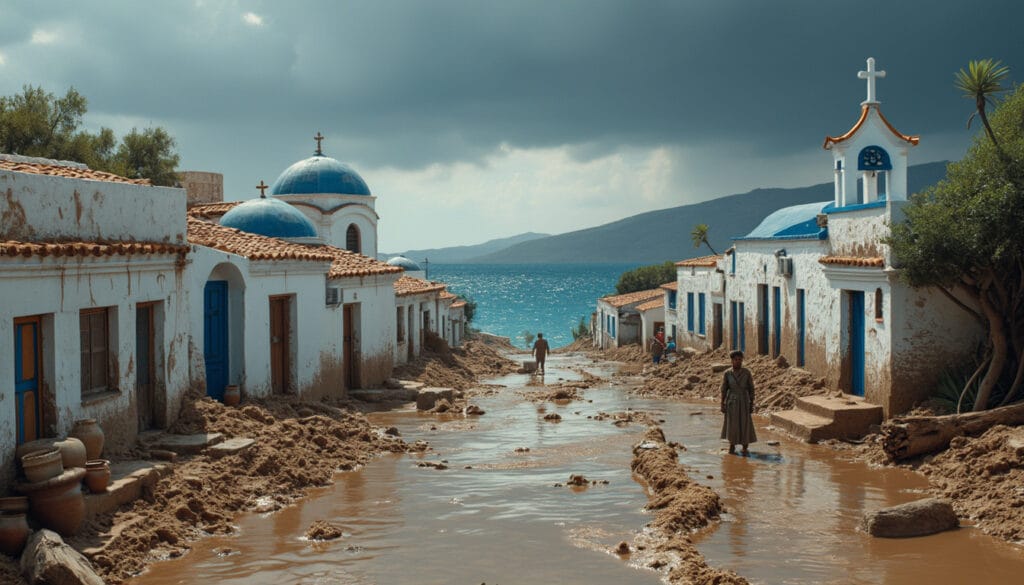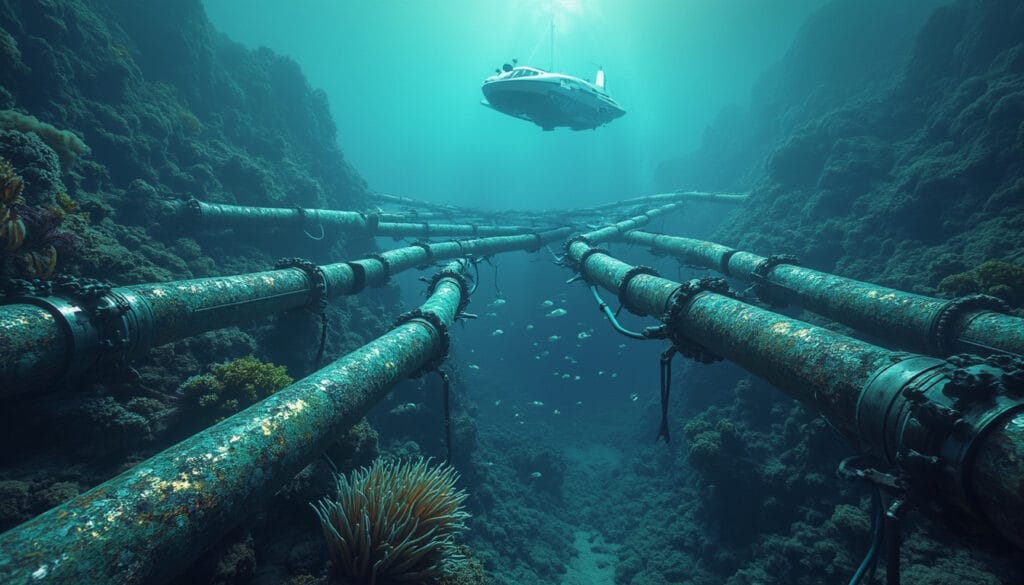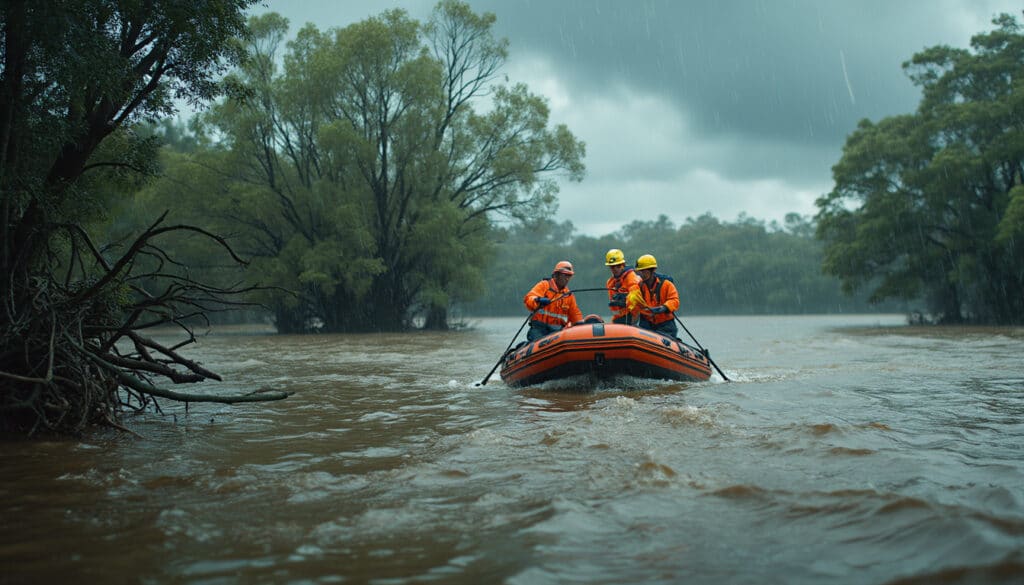The Aegean islands have been hit by flash floods, caused by typhoon-force winds. In the span of two hours, the disaster turned idyllic landscapes into apocalyptic scenes. Authorities quickly declared a state of emergency in some of Greece’s most sought-after destinations.
Paros and Mykonos, tourist jewels, are struggling to complete cleanup operations before the influx of Easter visitors. The streets have transformed into rivers of debris, where cars and beach furniture have been swept away by the tumultuous waters. The failure of flood management systems and unregulated development have exacerbated the vulnerability of these islands to extreme weather events. In the face of this crisis, the urgency for sustainable urban planning and investments in protective infrastructure becomes imperative.
The Aegean islands facing mud floods: a challenge before Easter
The Aegean islands of Greece, often dazzling in spring with their floral landscapes, have recently been struck by devastating mud floods. These extreme weather events, occurring less than three weeks before Easter, have plunged several popular destinations in the country into a state of emergency. But what led to this disaster and what are its repercussions for residents and tourists?
What are the causes of exceptional flooding on the Aegean islands?
The recent floods were triggered by hurricanes with winds equivalent to those of typhoons, causing torrential rains in just two hours. Costas Bizas, the mayor of Paros, the hardest-hit island, described the situation as a “total disaster.” The cyclones that struck Paros and Mykonos, two of the most touristy islands, generated excessive water flows that overwhelmed local infrastructure.
According to meteorologists, Paros received in a few hours more rain than would normally fall in an entire month. This phenomenon is partly attributed to climate change, which intensifies the frequency and severity of precipitation worldwide. The increase in extreme weather events is a direct consequence of climate degradation, as highlighted by Climate science: a new source of power for renewable energy.
How have authorities reacted to the disaster?
From the first hours of the floods, emergency services were mobilized to prevent an even heavier toll. In Paros and Mykonos, teams worked tirelessly to clean up the affected areas before the massive influx of tourists for the Easter holidays. The apocalyptic scenes reported included vehicles and beach furniture swept away by the waters, as well as streets transformed into waterways laden with debris.
In Chania, Crete, images of flooded streets and submerged public buildings illustrated the extent of the damage. Civil protection services advised residents to limit their movements and stay indoors for their safety. Despite these efforts, no casualties were reported, which was considered a miracle given the intensity of the floods.
What are the economic and social impacts of these floods?
The floods have had a devastating impact on tourism, a vital driver of the Greek economy. With hundreds of thousands of tourists expected for Easter, road closures and the destruction of hotel infrastructure threaten to cause a massive economic loss. Kriton Arsenis, a Greek ecologist, criticized unsustainable construction as the main factor exacerbating the floods. He explained that the rapid urbanization of Paros, which has seen a record number of building permits in recent years, has reduced the soil’s capacity to absorb rainwater, thereby accelerating runoff and water accumulation.
This situation also highlights the lack of preparedness for natural disasters in the Aegean islands. Flood management and civil protection are inadequate, compounded by poor urban planning. As noted by The world fails its first test of the COP renewable energy target, the lack of investments in climate-resilient infrastructure constitutes a major obstacle to energy and ecological transition.
What lessons can be learned for the future of the Aegean islands?
The recent disaster highlights the urgent need to review sustainable development policies and strengthen stormwater management systems. Kriton Arsenis emphasized the importance of preserving dry stone terraces, which retained water and prevented flooding, now replaced by impermeable constructions. To avoid future disasters, it is crucial to integrate ecological solutions such as rain gardens and green infrastructure that can absorb, store, and release water in a controlled manner.
Furthermore, Actuaries warn: economic growth could fall by 50% in two decades due to climate shocks highlights the importance of investing now in preventive measures to avoid irreversible economic and social damage. It is imperative that Greek authorities reassess their budget priorities to allocate more resources to civil protection and climate resilience.
What is the role of renewable energy in the climate resilience of the islands?
As a professional in the field of renewable energy, I see that sustainable solutions can play a key role in improving the climate resilience of the Aegean islands. Investments in wind and solar energy can not only reduce dependence on fossil fuels but also contribute to the energy stability necessary to support reconstruction efforts after natural disasters.
The climate science as a new source of power for renewable energy emphasizes the importance of scientific innovation in the development of technologies capable of mitigating the effects of climate change. For example, the integration of energy storage systems and smart grids can improve resource management during crises, thus ensuring rapid responsiveness in the event of floods or other extreme events.
What challenges exist in implementing flood defenses in the region?
Implementing flood defenses in the Aegean islands requires significant investment and close coordination between various local and national authorities. The lack of adequate funding, as indicated by The experts warn that the United Kingdom must invest £1.5 billion per year in flood defenses to ensure public safety, is a major obstacle. Greek islands, often underfunded due to their fluctuating populations between seasons, must rethink their financing strategies to ensure continuous protection year-round.
Moreover, the absence of effective drainage systems and the proliferation of unregulated constructions complicate the authorities’ task. To strengthen climate resilience, it is essential to adopt a holistic approach that integrates both physical infrastructure and sustainable management practices. This includes the restoration of natural terraces, the creation of buffer zones, and the use of permeable materials for new constructions.
How can local communities prepare for future floods?
The preparation of local communities is essential to minimize future damages and ensure the safety of residents and tourists. Education and awareness of preventive measures can greatly contribute to strengthening the resilience of populations in the face of natural disasters. Organizing training workshops on evacuation protocols, emergency management, and preserving critical infrastructure is crucial.
Additionally, encouraging community participation in planning and reconstruction efforts fosters a sense of solidarity and commitment. Residents can play an active role in the restoration of natural areas and the implementation of local projects aimed at improving stormwater management. Furthermore, the use of modern technologies, such as early warning systems and mobile risk management applications, can facilitate a rapid and coordinated response during a crisis.
What role does the energy transition play in flood protection?
The energy transition to renewable energy sources like wind can indirectly contribute to flood protection. By reducing dependence on traditional energy infrastructures, which are often vulnerable to natural disasters, renewable energies offer more resilient and sustainable solutions. For example, microgrids powered by wind turbines can continue to operate even in the event of a main grid failure, thus ensuring continuity of essential services during a crisis.
Moreover, green energy infrastructures can be integrated into water management strategies. Solar panels and wind turbines can be installed in a way that contributes to soil preservation and reduce excessive runoff. By investing in green technologies, the Aegean islands can not only reduce their carbon footprint but also improve their ability to face climate challenges.
What initiatives are necessary to strengthen the resilience of the Aegean islands?
To strengthen the resilience of the Aegean islands against mud floods and other natural disasters, several initiatives must be implemented. First, it is crucial to revise urban planning to limit construction in high-risk areas and promote sustainable developments. This involves strict regulation of new construction projects and the preservation of natural spaces that play a vital role in stormwater management.
Next, increasing investments in civil protection infrastructure is essential. This includes the construction of dikes, drainage channels, and buffer zones that can mitigate the impact of flooding. In addition, the ongoing training of emergency services and the establishment of early warning systems can improve responsiveness in the event of a disaster.
Finally, international collaboration and knowledge sharing between Greek islands and other regions facing similar challenges can foster the development of best practices and innovative solutions. Partnerships with renewable energy experts and climate risk management can also provide additional resources and essential technical skills to enhance the overall resilience of the Aegean islands.
Articles similaires
Thank you!
We will contact you soon.














